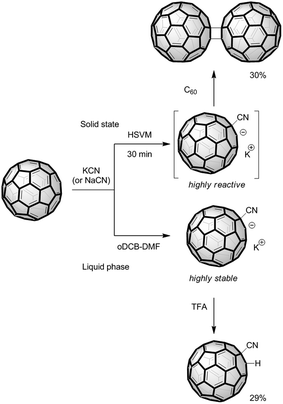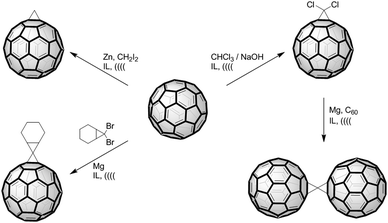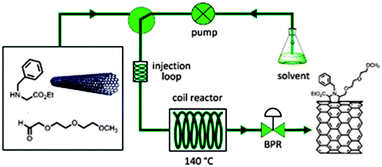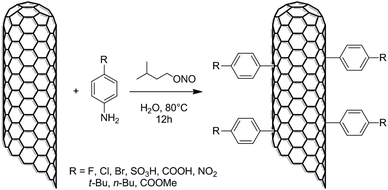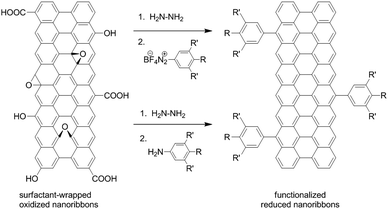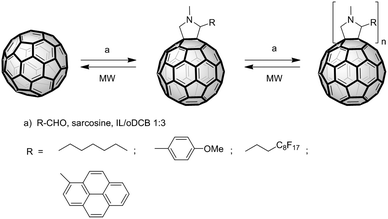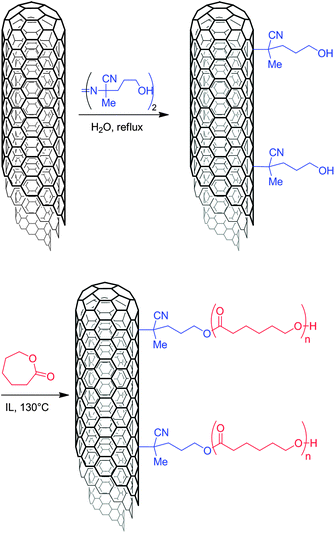Non-conventional methods and media for the activation and manipulation of carbon nanoforms
Ester Vázquez
*a,
Francesco Giacalone
*b and
Maurizio Prato
*c
aDepartamento de Química Orgánica, Facultad de Químicas-IRICA, Universidad de Castilla-La Mancha, Campus Universitario, 13071-Ciudad Real, Spain. E-mail: ester.vazquez@uclm.es
bDipartimento Scienze e Tecnologie Biologiche, Chimiche e Farmaceutiche (STEBICEF), Università degli Sudi di Palermo, Viale delle Scienze, Ed. 17, 90128 Palermo, Italy. E-mail: francesco.giacalone@unipa.it
cCenter of Excellence for Nanostructured Materials (CENMAT), INSTM, unit of Trieste, Dipartimento di Scienze Chimiche e Farmaceutiche, Università di Trieste, Piazzale Europa 1, 34127, Trieste, Italy. E-mail: prato@unit.it
First published on 15th August 2013
Abstract
Very often, chemical transformations require tedious and long procedures, which, sometimes, can be avoided using alternative methods and media. New protocols, enabling us to save time and solvents, allow us also to explore new reaction profiles. This Tutorial Review focuses on the physical and chemical behavior of carbon nanoforms, CNFs (fullerenes, nanotubes, nanohorns, graphene, etc.) when non-conventional methods and techniques, such as microwave irradiation, mechano-chemistry or highly ionizing radiations are employed. In addition, the reactivity of CNFs in non-conventional media such as water, fluorinated solvents, supercritical fluids, or ionic liquids is also discussed.
 Ester Vázquez | Ester Vázquez obtained her PhD degree from the University of Castilla-la Mancha (UCLM) in 2000. She carried out her postdoctoral training in Trieste, working with Professor Maurizio Prato, in the frame of a European Research Training Network. She joined the Faculty of Chemistry at UCLM in 2001, being promoted to Associate Professor in 2010. In 2009, she received the “Ibn Wafid de Toledo” prize for young researchers of Castilla-La Mancha. Her research interests focus on the modification of carbon nanostructures using non-conventional methodologies. |
Key learning points1. Carbon nanostructures absorb radiations very efficiently, so that microwaves and γ-rays can be used to enhance the reactivity behavior of these species.2. Carbon nanostructures are not soluble in most media, their reactivity can be explored under no solvent conditions. 3. Ball milling conditions can be applied to carbon nanoforms, nanotubes can be shortened, while graphite can be exfoliated efficiently into few-layer graphene. 4. Automation and scaling-up in the functionalization process can be explored through continuous flow techniques. 5. Chemical modification of carbon nanoforms can be studied successfully in green solvent media such as water, fluorinated solvents, supercritical fluids and ionic liquids. |
1 Introduction
Why are solvents used in chemical reactions? Are they really needed? It is commonly accepted that organic solvents are necessary to dissolve all the reactants and allow them to come into contact with each other and then react. This is only partially correct, as often solvents can play an active role, even acting as catalysts in some reactions. For instance, some time ago, water, used as a non-solubilizing medium, was found to accelerate some types of reactions. Similarly, the use of nanocapsules, as confined spaces to force inclusion complexes to react, became popular.Carbon nanoforms (CNFs) include, among others, fullerenes, carbon nanotubes and graphene. All these new materials have created great expectations in terms of practical applications and advancement of science. A main “negative” feature, common to all the CNFs is related to their difficult manipulation. Not only are CNFs usually sparingly soluble or totally insoluble in most or all solvents, but also their handling is strongly hindered by their heavy aggregation, which makes it very difficult to deal with individualized species. Just because of both scarce solubilization and strong aggregation, it is relatively difficult to study the reactivity behaviour of CNFs. Most of the time, very harsh reaction conditions are needed, such as Hummer's method for the exfoliation of graphite.1 In this context, the use of alternative, non-conventional ways for manipulating CNFs becomes particularly attractive. For instance, azomethine ylides cycloadd to carbon nanotubes (CNTs) in 5 days in DMF at temperatures next to the boiling point.2 Instead, using no solvent under microwave (MW) irradiation, the reaction only takes 1 h.3 Analogously, graphite can be relatively easily exfoliated using ball milling conditions.4
This review is dedicated to the description of non-conventional approaches to efficiently and mildly manipulate CNFs. Non-conventional methods and use of solvents enable the exploration of new reactivity profiles and allow us to access otherwise impossible reactions. Unfortunately, due to strong limitations in space and the number of references, as long as the intrinsic scope of the Tutorial Reviews of this journal is concerned, not all the possibilities will be described, the discussion being limited to the most popular examples only.
2 Non-conventional methods and techniques
2.1 Microwave irradiation
Microwave heating is an alternative way of conventional conductive heating. This technique uses the ability of some materials to transform electromagnetic energy into heat. This “in situ” mode of energy conversion is especially attractive when dealing with CNFs because these materials interact strongly with microwaves, reaching very high temperatures within seconds. Although the mechanism of CNF–microwave interaction is still not completely understood, the observed behaviour can be used for many interesting purposes.5One of the first demonstrations of microwave-assisted solvent-free manipulation of CNFs was published by our group in 2002, describing the purification of single-walled carbon nanotubes (SWNT).6 A main problem in practical applications of carbon nanotubes (CNTs) is that, even if they are currently produced on a large scale, impurities such as amorphous carbon and/or catalytic metal particles are always present in the as-synthesized products. While there have been many CNT purification techniques published in the literature, which include acid reflux, oxidation and filtration, most of them require long processing times or multiple stages, the use of large acid volumes and, what is even more important, the methods lead to damaged CNTs. The treatment of raw CNTs in a microwave oven under air presents a very easy way for improving the purity of this material, in which the selective burning of metal particles leads to a strong depletion of the iron content in the soot. Subsequent research has demonstrated that microwave assisted purification of CNTs is a promising technique for large-scale purification, inflicting insignificant damage to the CNTs and reducing significantly the processing times and the use of harmful products.7
Another stimulating possibility is the selective destruction of one type of nanotubes based on microwave treatment. As-synthesized SWNTs are usually produced as a mixture of both metallic and semiconducting tubes but, for many applications, the employment of “only” semiconducting ones is essential. Some authors have proposed a straightforward technique for the preferential destruction of metallic SWNTs under microwaves, based on the more efficient absorption of this type of tubes.8 This possibility is very attractive and the experimental results confirm the preferential disappearance of metallic nanotubes. The challenge here is that the degradation rate varies depending on the diameters of the metallic tubes. There are also issues related to the microwave absorption of metallic catalyst residues and to the progressive destruction of semiconducting tubes. These problems have been tackled by some authors by means of a facile technique combining microwave irradiation with mixed acid assisted-dispersion.9 The methodology is of great efficacy not only for purifying CNTs, but also for narrowing the diameter range. By mildly controlling experimental conditions both electronic type-dependent (metallic versus semiconducting) and diameter-dependent separation have been accomplished (Fig. 1).
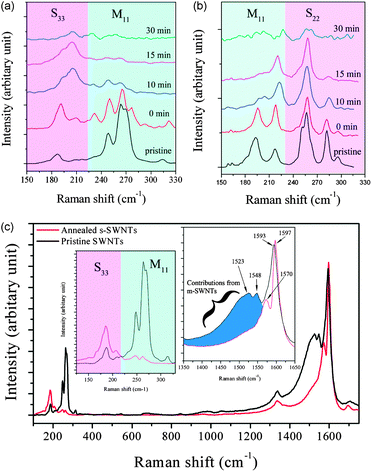 | ||
| Fig. 1 RBMs of Raman spectra for the treated and pristine samples obtained respectively at a 514.5 nm (a), and a 632.8 nm excitation wavelength (b). Raman spectra for the pristine and annealed s-SWNTs measured at a 514.5 nm wavelength (c). The inset shows magnified RBMs with the semiconducting (pink) and the metallic (blue) regions. Reprinted with permission from ref. 9. Copyright 2009, American Chemical Society. | ||
Especially important is the fact that under microwave radiation, the defective and damaged nanotubes can be supplied with sufficient energy to reorient any “defective” sp3 carbon bond into sp2 hybridization, in a quick and inexpensive annealing protocol.8 Lin and co-workers have developed an ultrafast microwave annealing process to reduce the defect density in vertically aligned CNTs. The as-annealed CNTs show dramatic improvements in thermal stability, mechanical properties, and electrical conductivity.10 These findings have also been applied to another interesting field: the preparation of graphene. Graphene has attracted tremendous attention because of its remarkable properties but the lack of a reliable large-scale production method is an on-going problem in the development of its applications. One possible approach for high volume production is the reduction of exfoliated graphite oxide (GO) sheets by means of reducing agents. MW irradiation can reduce GO to graphene rapidly and without any reducing agents or solvents. The response of GO with varying degrees of oxidation to MW irradiation has been carefully investigated. Though graphene is an excellent microwave absorbent, the increase of oxygen in GO remarkably decreases its microwave absorption capacity. Thus, the unoxidized graphitic regions in GO act as the microwave absorbent causing a local heating and initiating the microwave-induced reduction (Fig. 2).11
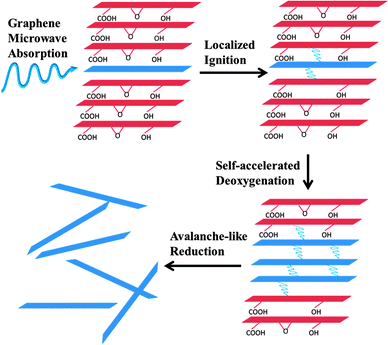 | ||
| Fig. 2 Illustration of the microwave reduction process: microwave absorption, igniting, and self-accelerating to avalanche-like deoxygenation and the formation of graphene. Adapted with permission from ref. 11. Copyright 2012, Elsevier Ltd. | ||
The strong microwave absorption of CNFs has also been used to promote their chemical functionalization. From the first application of microwave irradiation in the preparation of functionalized C60, described by Langa and colleagues, using an o-quinodimethane generated in situ,12 to the functionalization of graphene,13 different approaches have been described using this technique towards the covalent attachment of various organic groups, or simply chemical modification of the CNFs, as recently reviewed.14 In general, microwave irradiation reduces the reaction times and gives rise to derivatives with higher functionalization degrees and/or higher yields than those obtained by conventional thermal methods. The reaction conditions applied under microwaves have been, in most cases, similar to the ones used under classical heating, but surely the key point here is that this methodology allows the use of solvent-free modifications. In the absence of solvents, CNFs absorb the radiation directly and it is possible to take full advantage of the strong microwave absorption typical of these structures. In this way, very high temperatures are obtained in just seconds, providing extremely time-efficient reactions, but also making possible new transformations. Moreover, the solvent-free conditions pave the way for green protocols and large-scale functionalization. Thus, in 2002, we described the azomethine ylide cycloaddition reaction to CNTs.2 However, this process requires great amounts of DMF to disperse CNTs and long reaction times (five days). The same reaction using microwave activation avoids the use of solvents and takes place in just 1 hour.3 The methodology has been applied to produce multifunctionalized CNTs and carbon nanohorns (CNHs) using a combination of two different addition reactions, the 1,3-dipolar cycloaddition of azomethine ylides and the addition of diazonium salts, both via a simple, fast and environmentally friendly method (Fig. 3).15
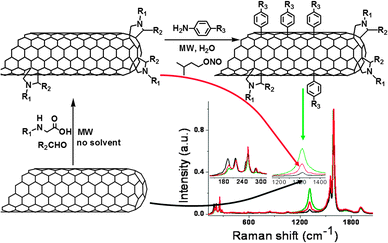 | ||
| Fig. 3 Microwave-assisted double functionalization of SWNTs. Raman spectra (λexc 633 nm) of pristine SWNTs (black line), SWNTs functionalized by 1,3-dipolar cycloaddition (red line) and doubly functionalized SWNTs by subsequent 1,3-dipolar cycloaddition and arylation (green line). Adapted with permission from ref. 15. Copyright 2008, American Chemical Society. | ||
Solvent-free conditions in combination with MW irradiation have been used for the malonate addition (Bingel reaction) in the functionalization of CNHs, further illustrating mild, energy- and time-efficient conditions for the modification of these nanostructures.16 The rapid and local heating of microwave absorbing carbon-based substrates in solvent-free conditions have also shown to be very effective for the rapid decomposition of metal salts, resulting in the instantaneous formation of metal and metal oxide nanoparticles on the substrate surfaces within seconds of microwave exposure. The methodology has shown to be widely applicable to various metal salts with different substrates including SWNTs and multiwalled carbon nanotubes (MWNTs), graphene and expanded graphite, forming substrate-supported metal (e.g., Ag, Au, Co, Ni, Pd, Pt) or metal oxide (e.g., Fe3O4, MnO, TiO2) nanoparticles in high yields (Fig. 4).17
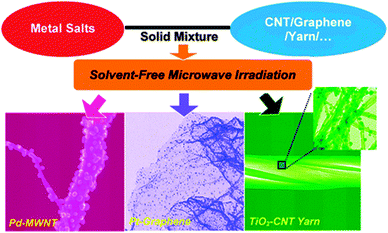 | ||
| Fig. 4 Formation of metal and metal oxide nanoparticles on carbon nanotubes and graphene via solvent-free microwave heating. Reprinted with permission from ref. 17. Copyright 2011, American Chemical Society. | ||
Although dielectric heating is the most familiar action of MW on a chemical reaction mixture, MW can also generate plasmas in gases. This is a completely different approach where carbon nanostructures are not the main actor but can really take advantage of the technique. Particle energies of plasmas are usually comparable with chemical bond energies; various kinds of precursor monomers can be activated into reactive radicals and thus, the surface functionalization even of the most inert materials can be conveniently tailored. Plasma treatments have been used, for example, to vaporize alkali metals and produce rapid diffusion of cations in solid C60, producing the rapid solid-state synthesis of alkali-metal fullerides18 or for producing the surface functionalization of CNTs with nitrogen, oxygen, or fluorine containing functional groups, enhancing the solubility and compatibility of CNTs in hydrophilic substrates using non-polluting and large scale procedures.19
2.2 Ball milling
Another method to distribute energy for producing chemical processes is the use of mechanical activation. According to IUPAC, a mechano-chemical reaction is defined as “a chemical reaction that is induced by the direct absorption of mechanical energy”. This latter energy can be generated and transferred to the reactants manually, using a mortar and a pestle, which can be defined as grinding, but this is only the simplest option. In order to ensure reproducibility and controlled reaction conditions milling devices such as planetary mills, are commonly used.While mechano-chemical processes are commonly used industrially, mainly with inorganic solids and materials, these activation methods have been less exploited in academic research. However in the last decade, the interest in this technique has risen enormously generating a number of review articles on the subject in which the advantages of the methodology are expounded, including greater efficiency with regard to time, materials and energy, and other green aspects related to solvent-free reactions. The use of this form of energy to modify the structure or the surface of CNFs has been of great interest.20
Transformations of graphite under mechanical treatment were investigated as early as the 1950's; however the structures produced with these treatments could not be thoroughly analyzed. In the last two decades, major advances in characterization techniques have permitted the analysis of the newly created structures, enabling researchers to use these mechano-chemical methodologies in order to produce controlled nanostructured materials.
Many studies have shown that during milling, graphite passes through a nanocrystalline phase prior to amorphization and thus the control on the conditions can lead to various nanostructures such as nanoribbons21 or CNTs by formation of new bonds between the free valence centers produced by milling.22
In a completely different approach, mechanical activation by milling processes has been recently applied to the exfoliation of graphite, a methodology that constitutes an attractive possibility for preparing scalable quantities of graphene. Our groups have shown how large quantities of inexpensive materials like graphite and melamine can be used for massive and fast production of few layer graphenes with a low concentration of defects (Fig. 5).4 The work opens the way for an alternative and efficient processing of graphene materials, such as film deposition and chemical functionalization. A similar methodology has also been recently applied in the preparation of core shell nanoparticles to improve the capacity and cycling performance of high-energy lithium batteries.23
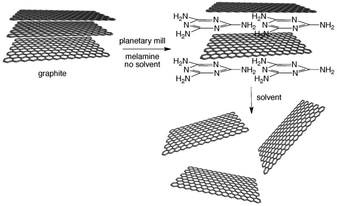 | ||
| Fig. 5 Schematic illustration for the exfoliation of graphite through ball-milling approach. Reproduced from ref. 4. | ||
Wet ball milling has also been used to exfoliate graphite platelets into few layer graphenes in a liquid medium. Multi-layered graphite nanosheets were dispersed into N,N-dimethylformamide (DMF) and exfoliated by ball milling.20 Starting from similar graphite platelets, the same group has described a method that achieves the preparation of polystyrene (PS)-functionalized graphene nanosheets homogeneously dispersed in a PS matrix via a one-step, in situ, ball milling method. This process has integrated preparation, functionalization, and incorporation in only one step, which avoids employing any other foreign modifier.24 Recently hydroxyl-functionalized graphene has been produced from exfoliation of graphite by ball milling with potassium hydroxide.20
The CNT structure allows mechanochemistry as well. The strong bonds are broken upon milling, producing free valences around the borders; this fact can be capitalized, for example, to produce short CNTs. For some applications, such as nanomedicine, the length of as-synthesized CNTs is a limitation. Very long CNTs have been found to be toxic, which makes short tubes better candidates for several scopes. For this reason, several ways to shorten CNTs have been devised, as a first step in the synthesis of CNT derivatives.
Single-walled carbon nanotubes (SWNTs) have been cut by ball-milling treatment.25 By tuning various parameters of ball milling such as atmosphere, time and rotational speed, scalable quantities of short SWNTs can be obtained, with a narrow distribution of length and minimal damage to the tubular structure. The process is very simple and compares very favourably with the most common way of cutting CNTs, namely, treatment with strong oxidizing acids. Moreover, disadvantages associated with the use of acid, such as pollution and corruption are avoided (Fig. 6).
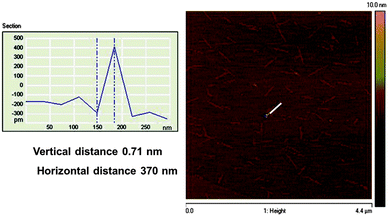 | ||
| Fig. 6 Topographic AFM image of short SWNTs, prepared by milling treatment at 250 rpm during 2 h in nitrogen atmosphere. The white line indicates the length of the tube (370 nm); the diameter of the tube is reported as the vertical distance (0.71 nm). Adapted with permission from ref. 25. Copyright 2011, Wiley VCH. | ||
In comparison with other conventional processes, mechano-chemical activation of CNFs offers several advantages: treatments can take place in the absence of solvents because mass transport limitations can be overcome and moreover the absence of solvation and the generation of local high pressures can produce some novel reactions. This fact was first observed with fullerenes treated under high speed vibration milling (HSVM) conditions. While some reactions proceed giving the expected products some others undergo quite different reaction pathways from those in solution and therefore give totally different products.20 This can be typically exemplified by the selective formation of fullerene dimer C120 (Scheme 1).
Other authors have used mechano-chemical methods to functionalize CNTs with many groups, such as hydroxyl, alkyl or aryl groups,20,25 or to solubilize nanotubes through the formation of complexes between CNTs and various derivatives (Fig. 7),26 or, also, to graft polymers onto the surface of CNTs.27 All these results suggest that the mechanical activation of CNTs is a very promising way of modifying CNTs. The introduction of mechanical stress through local deformations, such as kinking or twisting, may have similar effects on the atomic orbitals of CNT atoms, but to an extent that could be controlled by the amount of local bending.
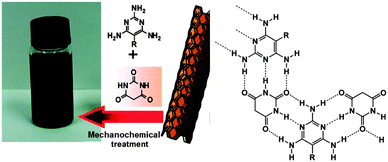 | ||
| Fig. 7 Solubilization of SWNTs by formation of supramolecular complexes of barbituric acid and triaminopyrimidines. Adapted with permission from ref. 26. Copyright 2007, American Chemical Society. | ||
2.3 Ultrasound
In the field of CNSs, ultrasound is often used, not only to induce dissolution and disentangling, but also to carry out reactions. The physical and chemical effects of sonochemistry can be resumed in terms of acoustic cavitation. Indeed, under high intensity ultrasound irradiation, liquids give rise to the formation, growth and collapse of bubbles. In addition, hot spots with temperature and pressure that can exceed 5000 K and hundreds of bars are formed leading to the formation of reactive species.28 The combination of sonochemistry and ionic liquids led to high yields in the synthesis of methanofullerenes (Scheme 2).29,30 In this case the above combination allowed us not only to obtain the addition of carbenes to fullerene in high yields, 55–84%, but also to exclusively isolate the [6,6]-cycloadducts. Parallel reactions carried out in THF instead of [BMIM][BF4] afforded a mixture of isomers in 6–21% yields.Very recently, the concomitant exfoliation of graphite flakes and the subsequent covalent functionalization of graphene, mono- and few layers, was reported.31 The “trick” was to use freshly distilled styrene both as a solvent and as a reactant, which under high intensity ultrasound irradiation (20 kHz, 50 W cm−2 at 0 °C under Ar) polymerized, while the chains graft onto the graphene surface. In such a way, about 10% of the starting graphite was functionalized, yielding a very soluble and stable polystyrene–graphene composite (∼2 mg mL−1 in DMF, THF, toluene and chloroform). The polymer content was 18 wt% and the reaction proved to be reproducible also for the grafting of poly(4-vinylpyridine) chains from 4-vinylpyridine.
We recently reported that few-layer graphenes, generated in solution in the presence of ferrocenecarboxyaldehyde (Fc-CHO) and ultrasound, produce MWCTs.32 The addition of Fc-CHO helps the rolling of the sheets and templates the formation of MWNTs, the encapsulation of ferrocene in the nanoscrolls being a highly exothermic process. Molecular mechanics and molecular dynamics calculations show that the presence of Fc-CHO decreases the activation barrier in the folding of the graphene surface. Fc-CHO at the edges of graphene guides the wrapping of the sheets, forming a nanoscroll, remaining entrapped and sewing the scroll into a tube. This finding matches the general consideration that CNTs are formed by rolled up graphene sheets (Fig. 8).
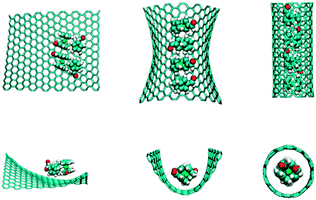 | ||
| Fig. 8 Ultrasound-assisted conversion of graphene into carbon nanotubes catalysed by ferrocenecarboxyaldehyde. Reprinted with permission from ref. 32. Copyright 2008, American Chemical Society. | ||
Sonication of graphite is a common and general way to induce exfoliation and produce graphene. However, sonication in air often produces heavily damaged sheets due to oxidation. Under sonication, free radicals are generated in solvents such as DMF, which then attack the extended π-system of graphene, leading to relatively small sheets. The addition of antioxidants, such as thiopronin, inhibits the action of the radicals and leads to structurally more perfect graphene layers.33
2.4 γ-Ray irradiation
Gamma rays are high frequency electromagnetic radiations with a broad field of applications from sterilizing purposes or food preservation processes to diagnostic uses in nuclear medicine. In materials science, γ-ray irradiation has been extensively used as a competitive way to initiate polymerizations, to modify polymers or prepare interpenetrating polymer networks. γ-Ray irradiation-induced reactions can be conducted at low temperatures and in liquid, gaseous or solid-state phase, which make this technique useful for surface modifications of organic or inorganic materials.Recently, highly ordered fullerenes nanofibrils have been produced.34 Firstly, C60 superstructures were formed using sublimable solvents such as naphthalene or camphor (above their melting points) which were subsequently evaporated. Then, the irradiation with γ-rays of the preorganized fcc C60 fibrils gave rise to rod-like polyfullerene structures with enhanced photoluminescence response, 12 times greater than that of C60 itself (Fig. 9).
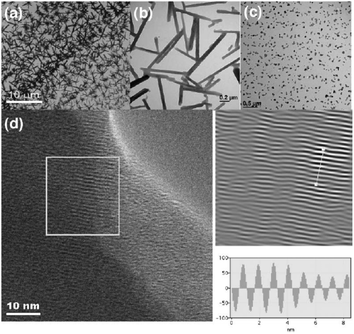 | ||
| Fig. 9 (a) Optical micrograph and TEM images of (b) the C60 superstructure and (c) pristine C60 after γ-ray irradiation for 24 hours. (d) HRTEM image of C60 superstructures after γ-ray irradiation for 24 hours showing the lattice fringes and image profile. Reproduced from ref. 34. | ||
On the other hand, γ-ray irradiation seems to have found wider application in the functionalization of MWNT. A linear relationship between the amount of γ-radiation and the introduction of functional groups and defects on MWNT has been reported.35 Taking advantage of these findings, several groups have been able to functionalize the sidewalls of MWNT with polymer chains, by simply applying γ-ray to monomer–MWNT mixtures. In such a way, radiolysis of the monomers takes place generating radicals which can polymerize, leading to nanotube functionalization, with the products free from residual initiators or catalysts. Soluble polystyrene-36 and poly(acrylic acid)-grafted37 MWNT have been obtained with a polymer loading in the 15–18 w/w% range. However, although this technique deserves a more in-depth exploration, real applications may be found mainly in the field of composite and nanomaterials, with very little chances for biomedical applications due to the high energy of γ-ray irradiation which can affect the chemical structure and composition in drug delivery systems.
2.5 Continuous flow
Continuous flow synthesis has emerged as a powerful tool for the scaling up of multi step chemical processes. Among the several advantages, such technology allows for careful reagents control, higher heat transfers and safer mixing even with hazardous chemicals with high levels of accuracy and reproducibility.38 The transposition of a multi-step process into a one-pot microreactor process inevitably carries a series of new experimental problems. However, chemists have used their knowledge and creativity to reach innovative solutions and alternative pathways to overcome the troubles.The great potential in the continuous flow scaling of the widely diffused fullerene acceptor in organic electronics PCBM (phenyl-C61-butyric acid methyl ester) was exploited.39 In this regard, the synthesis of the tert-butyl ester analogue (PCBtB) has been reported through the integrated use of three elements in a microreactor: (a) a renewable nickel peroxide cartridge for the conversion of tert-butyl-4-benzoylbutyrate hydrazone to the corresponding diazoderivative; (b) a first mixing bed in which C60 and the diazoderivative react at room temperature yielding the open [5,6]fulleroid in just 6 minutes; and (c) a photochemical reactor endowed with 75 watt cold and low power white LEDs for the conversion to the closed [6,6] methanofullerene (Fig. 10a).
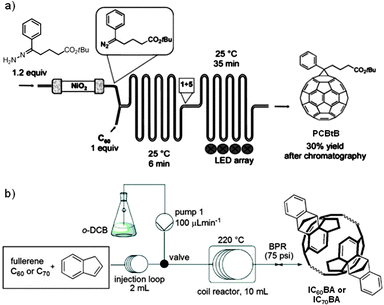 | ||
| Fig. 10 (a) The three-steps reaction sequence to PCBtB. (b) Continuous flow conditions for the synthesis of IC60BA and IC70BA. Adapted from ref. 39 and 40 (Copyright 2011, American Chemical Society), respectively. | ||
Although the amounts processed were not very high, ∼150 mg per day of PCBtB, the operational conditions were not optimized for massive efficiency, while several microreactors in parallel may boost the productivity. On the other hand, two novelties were introduced in the synthesis of PCBM and analogues: the use of NiO2 for generating in situ the reactive and hazardous diazoderivative and the use of cheap and low consuming LEDs for the photoconversion of the isomers.
Soon after, the synthesis of PCBM and other three different acceptors for solar cells employing a continuous flow approach was described (Fig. 10b).40 Here, the novelty was represented by the use of tetramethylpiperidine (TMP) as a base instead of sodium methoxide in pyridine and the use of high temperatures (250 °C) for the isomerization [5,6] to [6,6]. Analogously, the possibility to carry out reactions under pressure with superheated solvents in continuous flow allowed firstly the isomerization of indene to isoindene, and secondly the Diels–Alder reaction between the latter and C60 or C70 to produce the corresponding bisadducts IC60B and IC70BA. With the optimized microreactor up to 15 g of acceptor per day can be produced.
Finally, the continuous flow functionalization of single-walled, double-walled and multi-walled carbon nanotubes through cycloaddition of azomethine ylides was reported (Fig. 11).41 In the case of SWNTs, the same amount of functionalized nanotubes (10 mg) with the same solubility (∼1 mg ml−1 in N-cyclohexyl-2-pyrrolidone) could be produced in 7.5 h as compared to 72 h of flask reaction. Albeit the continuous flow synthesis allows for the scaling up of the chemical processes, prior to being applied it requires a large amount of time for the optimization of each step. Moreover, it becomes convenient when molecules or materials for real-life applications have to be prepared and, actually, there are just few CNFs which find application nowadays.
3 Unconventional reaction media
3.1 Water
The use of water as a solvent in organic reactions has received much attention in the last two decades. Besides the benefit of using a sustainable solvent-economical, non-toxic and non-flammable solvent, reactions in water are often accelerated showing an enhanced selectivity, mainly due to hydrophobic effects. In some cases, one major problem associated with the use of aqueous media is the lack of solubility of organic compounds in water, which can be circumvented by using surfactants. In this regard, the Diels–Alder reaction was one of the first processes performed with success in water, but attempts to use these conditions with C60 failed due to its insolubility. The use of dendritic polymers as nanocontainers has enabled the formation of C60 adducts under “eco-friendly” conditions, increasing the rate constants of the processes and affecting also the regioselectivity, leading to the exclusive formation of symmetrical antipodal trans-1-bis-adducts (Scheme 3).42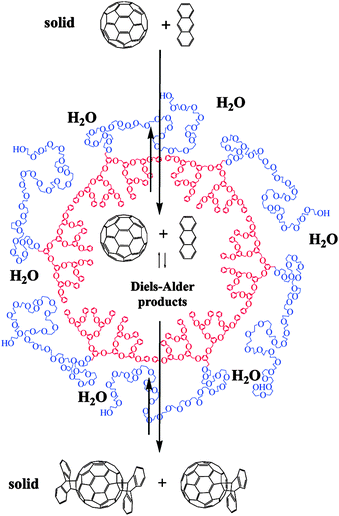 | ||
| Scheme 3 Mass transfer in and out of the Micellar Nanoreactor Entity. Reprinted with permission from ref. 42. Copyright 2008, American Chemical Society. | ||
Water was successfully used as a solvent for the mild covalent functionalization of SWNT with substituted anilines (Scheme 4).43 The vigorous stirring of nanotubes in the presence of the oxidizing isoamyl nitrite produced exfoliated and highly functionalized samples.
The radical aryl additions have also been employed with surfactant-wrapped chemically converted graphene sheets (GSs) and graphene nanoribbons (GNRs). In the former case, graphene oxide was chemically reduced with hydrazine and the nanosheets were treated with aryl diazonium salts for 1 hour to afford functionalized GS soluble in DMF, DMAc and NMP.44 In addition to the above protocol, after the chemical reduction GNRs were functionalized again by diazonium salts, generated by oxidation of anilines with isoamyl nitrite in water (Scheme 5).45 Also in the latter case the functionalized nanoribbons were readily soluble in organic solvents.
3.2 Fluorinated solvents
Perfluoroalkanes display a temperature-dependent low miscibility with common organic solvents, which increases with increasing temperature. Such immiscibility of fluorous and organic solvents, in conjunction with the differential solubilities, can be exploited to separate molecules with a fluorous tag from unlabeled compounds.46 This possibility leads to a multitude of different separation and purification strategies. Therefore, Diels–Alder reactions between C60 and perfluoroalkylated 1,3-cyclopentadiene were performed in a mixture of toluene and Freon 113 (1,1,2-trichlorotrifluoroethane), with the aim to simply extract the final product in the halogenated phase. However, the selective extraction was successful only when bis- and tris-adducts were formed. Better results were achieved from the same group with the C3 trisadduct of the Bingel reaction between fullerene and the bis(3-(perfluorooctyl)propyl)malonate (solvent: Freon 113/toluene).47 Such trisadduct not only showed a partition coefficient of 0.95 in perfluorooctanes against toluene but, in addition, sensitized singlet oxygen was produced in perfluorohexane with an outstanding lifetime for 1O2 of 7 ms.Later on, the photochemical functionalization of SWNT in perfluorohexane was successfully carried out.48 Raman, XPS and IR spectra clearly show that photolysis of perfluoroazooctane leads to the sidewall modification of the nanotubes even if not extensively.
Perfluorinated solvents are useful especially due to their chemical inertness and non-flammability, but their massive use is often limited by their high cost.
3.3 Supercritical fluids
Supercritical fluids (e.g. supercritical carbon dioxide, scCO2 or supercritical water, scW) are regarded as eco-friendly alternatives to organic solvents. There have been many examples of their use in chemical synthesis, usually under homogeneous conditions without the need for other solvents.49 In contrast to ionic liquids or fluorinated solvents, supercritical fluids represent a different kind of alternative solvent since they are not in the liquid state. In fact, these fluids show low viscosity and no surface tension, and the interactions between solvent molecules and the solute are weak, so high diffusivities are reached, close to those in the gas phase. In 2004 scCO2 resulted in being the best medium for the filling of open end SWNT with C60 at low temperatures (30–50 °C instead of the usual 350–450 °C).50 The supercritical fluid was highly effective yielding filling factors of up to 70% when six consecutive cycles of pressuring at 150 bar and depressuring at 100 bar at 50 °C were applied (Fig. 12).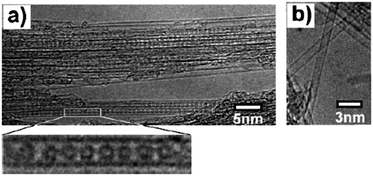 | ||
| Fig. 12 HR-TEM micrographs of (a) SWNTs of diameter 14.9 Å filled with C60 in scCO2 at room temperature. (b) SWNTs of diameter 13.6 Å remain empty under scCO2 filling conditions. Reproduced from ref. 50. | ||
Interestingly, such a reliable method resulted in being of general application since SWNTs were later filled with a functionalized fullerene derivative and an endohedral fullerene (Er3N@C60) though with lower yields. This method may be especially valuable for encapsulating labile molecules such as catalysts or drugs in nanotubes under very mild conditions.
Supercritical water (scW) in the presence and absence of oxygen proved to be an efficient method for the opening and peeling of the tips as well as for the thinning MWNT outer layers, this latter process being more pronounced with 2 mmol of oxygen.51 Later on, the same supercritical fluid has been employed for the functionalization of MWNT sidewalls in the presence of nitric acid (Scheme 6).52 Indeed, the diluted acid is responsible for the invasive modification of the graphitic layers, from the outer to the inner, leading to a semicomplete loss of the sp2 lattice in favour of a new sp3 system bearing CH2, C–O–C and C–OH groups with the latter responsible for high hygroscopicity.
More recently, supercritical ammonia has been utilized in the chemical modification of MWNT. Such a fluid was able to introduce several amino-groups in the pristine nanotubes, whilst it is more likely that the conversion of carboxylic groups into amides took place when oxidized MWNTs were used (Scheme 6).53
3.4 Ionic liquids
In the last decade the interest in room-temperature ionic liquids (ILs) has grown due to their unique properties. Among others, ILs present several recognized advantages such as non-volatility, tunability, high polarity, thermal resistance and are liquids in a wide range of temperatures.54In 2009, we proved that the combination of microwave irradiation and a 1![[thin space (1/6-em)]](https://www.rsc.org/images/entities/char_2009.gif) :
:![[thin space (1/6-em)]](https://www.rsc.org/images/entities/char_2009.gif) 3 [omim]BF4–o-DCB mixture allows us to obtain the 1,3-dipolar cycloaddition of azomethine ylides to C60 in high yield in just 2–10 minutes ([omim]BF4 = 1-methyl-3-N-octylimidazolium tetrafluoroborate) (Scheme 7).55 Interestingly, microwave irradiation of the so-formed fulleropyrrolidines dissolved in bulk [omim]BF4 gave rise to the complete cycloreversion within minutes releasing the pure and insoluble C60 (Scheme 7).56
3 [omim]BF4–o-DCB mixture allows us to obtain the 1,3-dipolar cycloaddition of azomethine ylides to C60 in high yield in just 2–10 minutes ([omim]BF4 = 1-methyl-3-N-octylimidazolium tetrafluoroborate) (Scheme 7).55 Interestingly, microwave irradiation of the so-formed fulleropyrrolidines dissolved in bulk [omim]BF4 gave rise to the complete cycloreversion within minutes releasing the pure and insoluble C60 (Scheme 7).56
ILs are able to form very stable gels in combination with nanotubes, in which debundling of entangled nanotubes takes place by means of simple grinding.57 IL bucky gels of SWNTs react smoothly in just 1 h (instead of the 120 h required under classical solvent conditions) under the same functionalization protocol with an applied power of 20 W, yielding group coverages of up to 1 per 60 carbon atoms.55 ILs are suitable SWNT functionalization media also for the radical addition of aryldiazonium salts in the presence of K2CO3.58 Simple mortar grinding of the reactants at room temperature during 15 minutes ensures highly functionalized nanotubes (up to 1/44 nanotube carbons). Moreover, the combination of IL exfoliation and high functionalization led to debundling and individualization of the nanotubes.
More recently, an interesting “green” multistep functionalization of MWNT was reported. Initially, 4-cyano-4-methylbutanol groups were introduced on the nanotube sidewalls by means of free radical addition of 4,4-azobis(4-cyanopentanol) in aqueous media (Scheme 8).59 The so formed MWNTs with terminal hydroxyl groups were in turn employed in the surface-initiated ring-opening polymerization of ε-caprolactone in [bmim]BF4 (1-methyl-3-N-butylimidazolium tetrafluoroborate) through a “grafting to” approach. In such a way, depending on the reaction time, four different MWNT-grafted-poly(ε-caprolactone) were obtained with polymer content in the 31–63 weight% range. It is worth noting that control experiments carried out in o-DCB instead of IL gave rise to a less functionalized polymer, confirming the latter media as the most advantageous ones to perform polymerization, probably due to the higher viscosity and polarity of [bmim]BF4.
Water and ILs have also been employed in the electrochemical synthesis of IL-functionalized graphene sheets.60 The application of a static potential of 15 V between two graphite rods immersed in a 1![[thin space (1/6-em)]](https://www.rsc.org/images/entities/char_2009.gif) :
:![[thin space (1/6-em)]](https://www.rsc.org/images/entities/char_2009.gif) 1 [omim]PF6–water mixture produced the exfoliation of graphene nanosheets which bear imidazolium salts covalently linked, as demonstrated by TGA, IR and UV analyses.
1 [omim]PF6–water mixture produced the exfoliation of graphene nanosheets which bear imidazolium salts covalently linked, as demonstrated by TGA, IR and UV analyses.
ILs revealed to be a very useful medium for CNFs, especially for debundling and dispersing nanotubes and graphene, but their wide use is still limited by their high cost. Moreover, some reactions, such as radical processes, can afford unpredictable products if carried out in ILs.
4 Conclusions
Representative examples of the physical and chemical behavior of carbon nanoforms with non-conventional methods or in alternative media have been discussed. The adoption of alternative methods and solvents enable the exploration of new reactivity profiles and allow us to access otherwise impossible reactions. Moreover, some of these methodologies permit carrying out fast and easy purification protocols, as in the case of microwave-treated nanotubes. Other clear examples are the use of mild ball milling or sonochemistry techniques for the exfoliation of graphite to graphene, thus avoiding harsh treatments, often but not always employed, which can affect the properties of the CNFs. Other methods, such as γ-ray irradiation have found application in the easy but yet non-optimized functionalization of MWNTs with commercial polymers. Finally, the continuous flow technique has been recently applied to the functionalization of CNFs in microreactors, paving the way to the scaled-up production of electron acceptor for organic photovoltaics. On the other hand it seems almost natural that non-conventional materials such as CNFs, sparingly soluble or totally insoluble in most or all solvents, will be prone to chemical functionalization in non-conventional reaction media like water, supercritical fluids, fluorinated solvents or ionic liquids.Acknowledgements
This work was supported, in part, by the the Spanish Ministerio de Economía y Competitividad (project CTQ2011-22410 and IPT-2012-0429-420000) and by the Italian Ministry of Education MIUR (cofin Prot. 2010N3T9M4). We thank Dr Matteo Calvaresi, University of Bologna, for making Fig. 8 available to us.Notes and references
- W. Cai, R. D. Piner, F. J. Stadermann, S. Park, M. A. Shaibat, Y. Ishii, D. Yang, A. Velamakanni, S. J. An, M. Stoller, J. An, D. Chen and R. S. Ruoff, Science, 2008, 321, 1815–1817 CrossRef CAS PubMed.
- V. Georgakilas, K. Kordatos, M. Prato, D. M. Guldi, M. Holzinger and A. Hirsch, J. Am. Chem. Soc., 2002, 124, 760–761 CrossRef CAS PubMed.
- F. G. Brunetti, M. A. Herrero, J. D. M. Munoz, S. Giordani, A. Diaz-Ortiz, S. Filippone, G. Ruaro, M. Meneghetti, M. Prato and E. Vazquez, J. Am. Chem. Soc., 2007, 129, 14580–14581 CrossRef CAS PubMed.
- V. Leon, M. Quintana, M. Antonia Herrero, J. L. G. Fierro, A. de la Hoz, M. Prato and E. Vazquez, Chem. Commun., 2011, 47, 10936–10938 RSC.
- E. Vazquez and M. Prato, ACS Nano, 2009, 3, 3819–3824 CrossRef CAS PubMed and references therein.
- E. Vazquez, V. Georgakilas and M. Prato, Chem. Commun., 2002, 2308–2309 RSC.
- K. MacKenzie, O. Dunens and A. T. Harris, Sep. Purif. Technol., 2009, 66, 209–222 CrossRef CAS PubMed and references therein.
- B. R. Priya and H. J. Byrne, J. Phys. Chem. C, 2009, 113, 7134–7138 CAS.
- H. Qiu, Y. Maeda and T. Akasaka, J. Am. Chem. Soc., 2009, 131, 16529–16533 CrossRef CAS PubMed.
- W. Lin, K.-S. Moon, S. Zhang, Y. Ding, J. Shang, M. Chen and C.-p. Wong, ACS Nano, 2010, 4, 1716–1722 CrossRef CAS PubMed.
- H. Hu, Z. Zhao, Q. Zhou, Y. Gogotsi and J. Qiu, Carbon, 2012, 50, 3267–3273 CrossRef CAS PubMed.
- B. Illescas, N. Martin, C. Seoane, P. Delacruz, F. Langa and F. Wudl, Tetrahedron Lett., 1995, 36, 8307–8310 CAS.
- S. P. Economopoulos, G. Rotas, Y. Miyata, H. Shinohara and N. Tagmatarchis, ACS Nano, 2010, 4, 7499–7507 CrossRef CAS PubMed.
- S. P. Economopoulos, N. Karousis, G. Rotas, G. Pagona and N. Tagmatarchis, Curr. Org. Chem., 2011, 15, 1121–1132 CrossRef CAS.
- F. G. Brunetti, M. A. Herrero, J. D. Munoz, A. Diaz-Ortiz, J. Alfonsi, M. Meneghetti, M. Prato and E. Vazquez, J. Am. Chem. Soc., 2008, 130, 8094–8100 CrossRef CAS PubMed.
- S. P. Economopoulos, G. Pagona, M. Yudasaka, S. Iijima and N. Tagmatarchis, J. Mater. Chem., 2009, 19, 7326 RSC.
- Y. Lin, D. W. Baggett, J.-W. Kim, E. J. Siochi and J. W. Connell, ACS Appl. Mater. Interfaces, 2011, 3, 1652–1664 CAS.
- R. E. Douthwaite, M. L. H. Green and M. J. Rosseinsky, Chem. Mater., 1996, 8, 394–400 CrossRef CAS.
- C. Chen, B. Liang, A. Ogino, X. Wang and M. Nagatsu, J. Phys. Chem. C, 2009, 113, 7659–7665 CAS.
- S.-E. Zhu, F. Li and G.-W. Wang, Chem. Soc. Rev., 2013 10.1039/C3CS35494F and references therein.
- N. J. Welham, V. Berbenni and P. G. Chapman, J. Alloys Compd., 2003, 349, 255–263 CrossRef CAS.
- Y. B. Li, B. Q. Wei, J. Liang, Q. Yu and D. H. Wu, Carbon, 1999, 37, 493–497 CrossRef CAS.
- Z. Chen, M. Zhou, Y. Cao, X. Ai, H. Yang and J. Liu, Adv. Energy Mater., 2012, 2, 95–102 CrossRef CAS.
- H. Wu, W. Zhao, H. Hu and G. Chen, J. Mater. Chem., 2011, 21, 8626 RSC.
- N. Rubio, C. Fabbro, M. A. Herrero, A. de la Hoz, M. Meneghetti, J. L. G. Fierro, M. Prato and E. Vazquez, Small, 2011, 7, 665–674 CrossRef CAS PubMed and references therein.
- A. Ikeda, Y. Tanaka, K. Nobusawa and J. Kikuchi, Langmuir, 2007, 23, 10913–10915 CrossRef CAS PubMed and references therein.
- V. Ambrogi, G. Gentile, C. Ducati, M. C. Oliva and C. Carfagna, Polymer, 2012, 53, 291–299 CrossRef CAS PubMed.
- J. H. Bang and K. S. Suslick, Adv. Mater., 2010, 22, 1039–1059 CrossRef CAS PubMed.
- Z. Yinghuai, S. Bahnmueller, C. Chibun, K. Carpenter, N. S. Hosmane and J. A. Maguire, Tetrahedron Lett., 2003, 44, 5473–5476 CrossRef.
- Z. Yinghuai, J. Phys. Chem. Solids, 2004, 65, 349–353 CrossRef PubMed.
- H. Xu and K. S. Suslick, J. Am. Chem. Soc., 2011, 133, 9148–9151 CrossRef CAS PubMed.
- M. Quintana, M. Grzelczak, K. Spyrou, M. Calvaresi, S. Bals, B. Kooi, G. Van Tendeloo, P. Rudolf, F. Zerbetto and M. Prato, J. Am. Chem. Soc., 2012, 134, 13310–13315 CrossRef CAS PubMed.
- M. Quintana, M. Grzelczak, K. Spyrou, B. Kooi, S. Bals, G. V. Tendeloo, P. Rudolf and M. Prato, Chem. Commun., 2012, 48, 12159–12161 RSC.
- S. Malik, N. Fujita, P. Mukhopadhyay, Y. Goto, K. Kaneko, T. Ikeda and S. Shinkai, J. Mater. Chem., 2007, 17, 2454 RSC.
- J. Guo, Y. Li, S. Wu and W. Li, Nanotechnology, 2005, 16, 2385–2388 CrossRef CAS PubMed.
- H. Xu, X. Wang, Y. Zhang and S. Liu, Chem. Mater., 2006, 18, 2929–2934 CrossRef CAS.
- S. Chen, G. Wu, Y. Liu and D. Long, Macromolecules, 2006, 39, 330–334 CrossRef CAS.
- B. P. Mason, K. E. Price, J. L. Steinbacher, A. R. Bogdan and D. T. McQuade, Chem. Rev., 2007, 107, 2300–2318 CrossRef CAS PubMed.
- E. Rossi, T. Carofiglio, A. Venturi, A. Ndobe, M. Muccini and M. Maggini, Energy Environ. Sci., 2011, 4, 725 Search PubMed.
- H. Seyler, W. W. H. Wong, D. J. Jones and A. B. Holmes, J. Org. Chem., 2011, 76, 3551–3556 CrossRef CAS PubMed.
- P. Salice, P. Maity, E. Rossi, T. Carofiglio, E. Menna and M. Maggini, Chem. Commun., 2011, 47, 9092 RSC.
- A. Simonyan and I. Gitsov, Langmuir, 2008, 24, 11431–11441 CrossRef CAS PubMed.
- B. K. Price and J. M. Tour, J. Am. Chem. Soc., 2006, 128, 12899–12904 CrossRef CAS PubMed.
- J. R. Lomeda, C. D. Doyle, D. V. Kosynkin, W.-F. Hwang and J. M. Tour, J. Am. Chem. Soc., 2008, 130, 16201–16206 CrossRef CAS PubMed.
- Y. Zhu, A. L. Higginbotham and J. M. Tour, Chem. Mater., 2009, 21, 5284–5291 CrossRef CAS.
- C. C. Tzschucke, C. Markert, W. Bannwarth, S. Roller, A. Hebel and R. Haag, Angew. Chem., Int. Ed., 2002, 41, 3964–4000 CrossRef CAS.
- S. R. Wilson, M. E. Yurchenko, D. I. Schuster, E. N. Yurchenko, O. Sokolova, S. E. Braslavsky and G. Klihm, J. Am. Chem. Soc., 2002, 124, 1977–1981 CrossRef CAS PubMed.
- T. Nakamura, M. Ishihara, T. Ohana, A. Tanaka and Y. Koga, Chem. Commun., 2004, 1336 RSC.
- D. J. Adams, P. J. Dyson and S. J. Tavener, Chemistry in Alternative Reaction Media, John Wiley & Sons, Ltd, 2004 Search PubMed.
- A. N. Khlobystov, D. A. Britz, J. Wang, S. A. O'Neil, M. Poliakoff and G. A. D. Briggs, J. Mater. Chem., 2004, 14, 2852–2857 RSC.
- J.-Y. Chang, A. Ghule, J.-J. Chang, S.-H. Tzing and Y.-C. Ling, Chem. Phys. Lett., 2002, 363, 583–590 CrossRef CAS.
- K. C. Park, T. Hayashi, H. Tomiyasu, M. Endo and M. S. Dresselhaus, J. Mater. Chem., 2005, 15, 407 RSC.
- L. Shao, Y. Bai, X. Huang, Z. Gao, L. Meng, Y. Huang and J. Ma, Mater. Chem. Phys., 2009, 116, 323–326 CrossRef CAS PubMed.
- P. Wasserscheid and T. Welton, Ionic Liquids in Synthesis, Wiley-VCH, 2nd edn, 2008 Search PubMed.
- I. Guryanov, F. M. Toma, A. Montellano López, M. Carraro, T. Da Ros, G. Angelini, E. D'Aurizio, A. Fontana, M. Maggini, M. Prato and M. Bonchio, Chem.–Eur. J., 2009, 15, 12837–12845 CrossRef CAS PubMed.
- I. Guryanov, A. Montellano López, M. Carraro, T. Da Ros, G. Scorrano, M. Maggini, M. Prato and M. Bonchio, Chem. Commun., 2009, 3940 RSC.
- T. Fukushima, A. Kosaka, Y. Ishimura, T. Yamamoto, T. Takigawa, N. Ishii and T. Aida, Science, 2003, 300, 2072–2074 CrossRef CAS PubMed.
- B. K. Price, J. L. Hudson and J. M. Tour, J. Am. Chem. Soc., 2005, 127, 14867–14870 CrossRef CAS PubMed.
- Y. Yang, S. Qiu, C. He, W. He, L. Yu and X. Xie, Appl. Surf. Sci., 2010, 257, 1010–1014 CrossRef CAS PubMed.
- N. Liu, F. Luo, H. Wu, Y. Liu, C. Zhang and J. Chen, Adv. Funct. Mater., 2008, 18, 1518–1525 CrossRef CAS.
| This journal is © The Royal Society of Chemistry 2014 |



